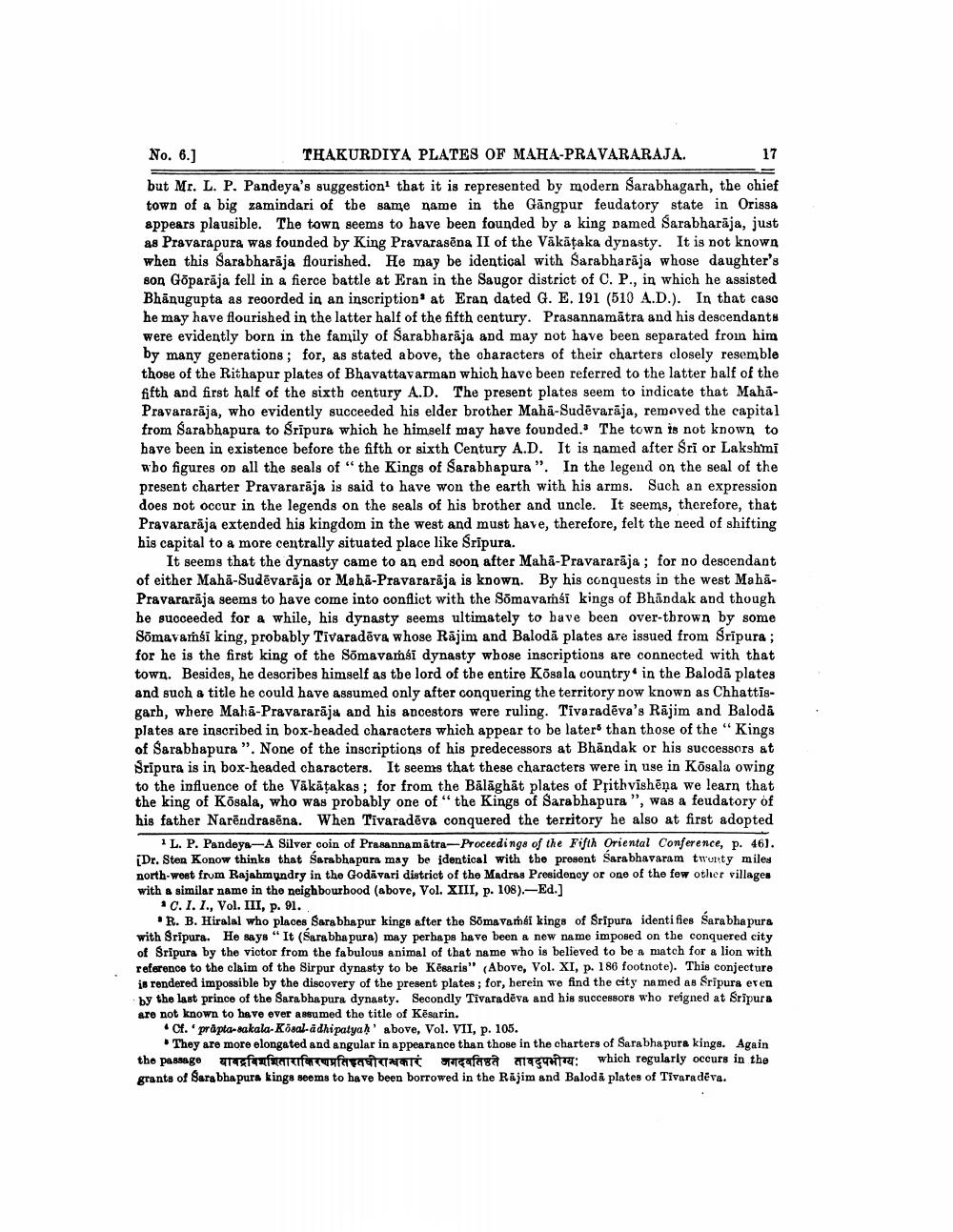________________
No. 6.]
THAKURDIYA PLATES OF MAHA-PRAVARARAJA.
17
but Mr. L. P. Pandeya's suggestion that it is represented by modern Sarabhagarh, the chief town of a big zamindari of the same name in the Gangpur feudatory state in Orissa appears plausible. The town seems to have been founded by a king named Sarabharaja, just as Pravarapura was founded by King Pravarasena II of the Vākāṭaka dynasty. It is not known when this Sarabharaja flourished. He may be identical with Sarabharaja whose daughter's son Gōparāja fell in a fierce battle at Eran in the Saugor district of C. P., in which he assisted Bhanugupta as recorded in an inscription at Eran dated G. E. 191 (510 A.D.). In that case he may have flourished in the latter half of the fifth century. Prasannamātra and his descendants were evidently born in the family of Sarabharaja and may not have been separated from him by many generations; for, as stated above, the characters of their charters closely resemble those of the Rithapur plates of Bhavattavarman which have been referred to the latter half of the fifth and first half of the sixth century A.D. The present plates seem to indicate that MahaPravararaja, who evidently succeeded his elder brother Maha-Sudēvarāja, removed the capital from Sarabhapura to Sripura which he himself may have founded. The town is not known to have been in existence before the fifth or sixth Century A.D. It is named after Śrī or Lakshmi who figures on all the seals of "the Kings of Sarabhapura". In the legend on the seal of the present charter Pravararāja is said to have won the earth with his arms. Such an expression does not occur in the legends on the seals of his brother and uncle. It seems, therefore, that Pravararāja extended his kingdom in the west and must have, therefore, felt the need of shifting his capital to a more centrally situated place like Sripura.
It seems that the dynasty came to an end soon after Maha-Pravararāja; for no descendant of either Maha-Sudevaraja or Maha-Pravararaja is known. By his conquests in the west MahaPravararāja seems to have come into conflict with the Sōmavamsi kings of Bhandak and though he succeeded for a while, his dynasty seems ultimately to have been over-thrown by some Sōmavamsi king, probably Tivaradeva whose Rajim and Baloda plates are issued from Sripura; for he is the first king of the Sōmavamsi dynasty whose inscriptions are connected with that town. Besides, he describes himself as the lord of the entire Kōsala country in the Balodā plates and such a title he could have assumed only after conquering the territory now known as Chhattisgarh, where Maha-Pravararaja and his ancestors were ruling. Tivaradeva's Rājim and Baloda plates are inscribed in box-headed characters which appear to be later than those of the "Kings of Sarabhapura". None of the inscriptions of his predecessors at Bhandak or his successors at Sripura is in box-headed characters. It seems that these characters were in use in Kōsala owing to the influence of the Vākāṭakas; for from the Balaghat plates of Prithvishēņa we learn that the king of Kōsala, who was probably one of the Kings of Sarabhapura", was a feudatory of his father Narendrasena. When Tivaradeva conquered the territory he also at first adopted
1 L. P. Pandeya-A Silver coin of Prasanna mätra-Proceedings of the Fifth Oriental Conference, p. 461. ¡Dr. Sten Konow thinks that Sarabhapura may be identical with the present Sarabhavaram twenty miles north-west from Rajahmundry in the Godavari district of the Madras Presidency or one of the few other villages with a similar name in the neighbourhood (above, Vol. XIII, p. 108).-Ed.]
C. I. I., Vol. III, p. 91..
R. B. Hiralal who places Sarabhapur kings after the Sōmavaméi kings of Sripura identifies Sarabhapura with Sripura. He says "It (Sarabha pura) may perhaps have been a new name imposed on the conquered city of Sripura by the victor from the fabulous animal of that name who is believed to be a match for a lion with reference to the claim of the Sirpur dynasty to be Kesaris" (Above, Vol. XI, p. 186 footnote). This conjecture is rendered impossible by the discovery of the present plates; for, herein we find the city named as Sripura even by the last prince of the Sarabhapura dynasty. Secondly Tivaradeva and his successors who reigned at Sripura
are not known to have ever assumed the title of Kesarin.
Cf. 'prapta-sakala-Kosal-adhipatyaḥ' above, Vol. VII, p. 105.
They are more elongated and angular in appearance than those in the charters of Sarabhapura kings. Again the passage यावद्रविशशिताराकिरणप्रतिहतघोरान्धकारं जगदवतिष्ठते तावदुपभोग्य: which regularly occurs in the grants of Sarabhapura kings seems to have been borrowed in the Rājim and Balodā plates of Tivaradeva.




